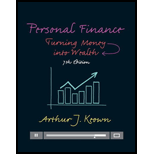
Austin and Anya Gould are a middle-aged couple with two children, Rusty, age 13, and Sam, age 11, whom they adopted this year. They also bought a new home in the area to give the children a yard in which to play. The Goulds have an extensive retirement portfolio invested primarily in growth-oriented mutual funds. Their annual investment income is only $500, none of which is attributable to
The Goulds give extensively to charities. They also have tax deductions from their mortgage interest expense, business expenses, tax expenses, and unreimbursed medical expenses, as follows:
| Health insurance (provided by Anya) | $2,200 |
| Rusty’s braces | $1,500 |
| Mortgage interest expense | $7,200 |
| Real estate taxes | $900 |
| Investment and tax planning expenses | $1,450 |
| Other medical expenses | $3,600 |
| Charitable contributions | $3,500 |
| Moving expenses | $3,000 |
| Austin’s unreimbursed business expenses | $2,300 |
| Qualified adoption expenses | $6,700 |
| State taxes withheld and owed | $4,000 |
6. What credits might the Goulds use to reduce their tax iability?
Want to see the full answer?
Check out a sample textbook solution
Chapter 4 Solutions
Personal Finance: Turning Money into Wealth (7th Edition) (Prentice Hall Series in Finance)
- Adidas annual income statement 2022-2023 and 2024arrow_forwardNikes annual balance sheet and income statement for 2022-2023 and 2024arrow_forwardWhat is the value at the end of year 3 of a perpetual stream of $70,000 semi-annual payments that begins at the end of year 7? The APR is 12% compounded quarterly.arrow_forward
- Firm A must pay $258,000 to firm B in 10 years. The discount rate is 16.44 percent per year. What is the present value of the cash flow associated with this arrangement for firm A? -I got the answer of 56331.87773=56332 (rounded to the nearest dollar), but it says incorrect.arrow_forwardSuppose you have two histograms: one where the mean equals the median, and one where the mean is different from the median. How would you expect the two histograms to differ.arrow_forward(a) The variables have been stripped of their names. Which one do you think is "household income" ?(b) Calculate the mean, median, and standard deviation of household income. Do these numbers fit with your expectations? (c) Suppose you have two histograms: one where the mean equals the median, and one where the mean is different from the median. How would you expect the two histograms to differ?arrow_forward
- Janet Foster bought a computer and printer at Computerland. The printer had a $860 list price with a $100 trade discount and 210210 , n30n30 terms. The computer had a $4,020 list price with a 25% trade discount but no cash discount. On the computer, Computerland offered Janet the choice of (1) paying $150 per month for 17 months with the 18th payment paying the remainder of the balance or (2) paying 6% interest for 18 months in equal payments. Assume Janet could borrow the money for the printer at 6% to take advantage of the cash discount. How much would Janet save? Note: Use 360 days a year. Round your answer to the nearest cent.arrow_forwardDon't used Ai solutionarrow_forwardConsider the following cash flows on two mutually exclusive projects for the Bahamas Recreation Corporation (BRC). Both projects require an annual return of 14 percent. New Submarine Deepwater Fishing Year Ride 0 -$875,000 1 330,000 2 480,000 3 440,000 -$1,650,000 890,000 730,000 590,000 a-1. Compute the IRR for both projects. (Do not round intermediate calculations and enter your answers as a percent rounded to 2 decimal places, e.g., 32.16.) Deepwater Fishing Submarine Ride 19.16 % 17.50% a-2. Based on the IRR, which project should you choose? Deepwater Fishing Submarine Ride b-1. Calculate the incremental IRR for the cash flows. (Do not round intermediate calculations and enter your answer as a percent rounded to 2 decimal places, e.g., 32.16.) Incremental IRR 14.96 % b-2. Based on the incremental IRR, which project should you choose? Submarine Ride Deepwater Fishingarrow_forward
 Individual Income TaxesAccountingISBN:9780357109731Author:HoffmanPublisher:CENGAGE LEARNING - CONSIGNMENT
Individual Income TaxesAccountingISBN:9780357109731Author:HoffmanPublisher:CENGAGE LEARNING - CONSIGNMENT





